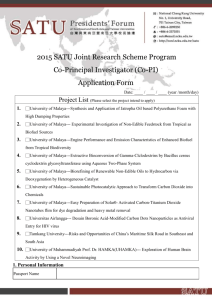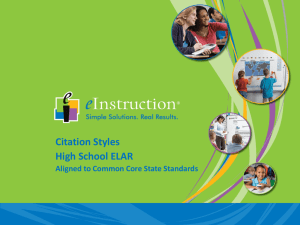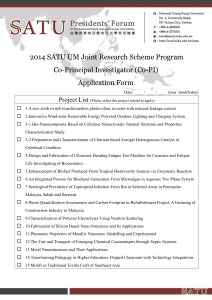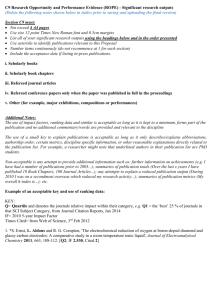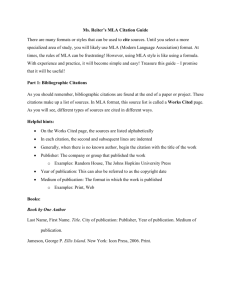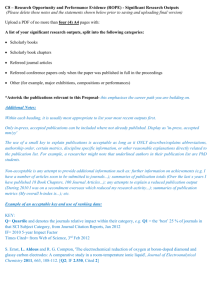MLA Quick Guide - s3.amazonaws.com
advertisement
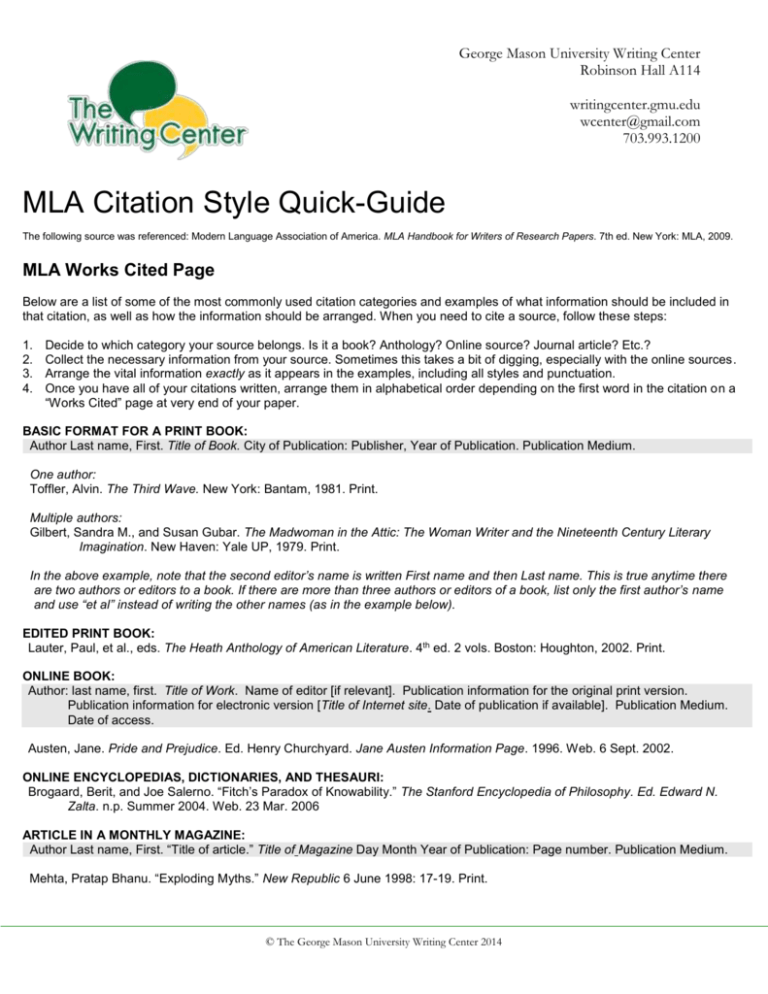
George Mason University Writing Center Robinson Hall A114 writingcenter.gmu.edu wcenter@gmail.com 703.993.1200 MLA Citation Style Quick-Guide The following source was referenced: Modern Language Association of America. MLA Handbook for Writers of Research Papers. 7th ed. New York: MLA, 2009. MLA Works Cited Page Below are a list of some of the most commonly used citation categories and examples of what information should be included in that citation, as well as how the information should be arranged. When you need to cite a source, follow these steps: 1. 2. 3. 4. Decide to which category your source belongs. Is it a book? Anthology? Online source? Journal article? Etc.? Collect the necessary information from your source. Sometimes this takes a bit of digging, especially with the online sources. Arrange the vital information exactly as it appears in the examples, including all styles and punctuation. Once you have all of your citations written, arrange them in alphabetical order depending on the first word in the citation on a “Works Cited” page at very end of your paper. BASIC FORMAT FOR A PRINT BOOK: Author Last name, First. Title of Book. City of Publication: Publisher, Year of Publication. Publication Medium. One author: Toffler, Alvin. The Third Wave. New York: Bantam, 1981. Print. Multiple authors: Gilbert, Sandra M., and Susan Gubar. The Madwoman in the Attic: The Woman Writer and the Nineteenth Century Literary Imagination. New Haven: Yale UP, 1979. Print. In the above example, note that the second editor’s name is written First name and then Last name. This is true anytime there are two authors or editors to a book. If there are more than three authors or editors of a book, list only the first author’s name and use “et al” instead of writing the other names (as in the example below). EDITED PRINT BOOK: Lauter, Paul, et al., eds. The Heath Anthology of American Literature. 4th ed. 2 vols. Boston: Houghton, 2002. Print. ONLINE BOOK: Author: last name, first. Title of Work. Name of editor [if relevant]. Publication information for the original print version. Publication information for electronic version [Title of Internet site. Date of publication if available]. Publication Medium. Date of access. Austen, Jane. Pride and Prejudice. Ed. Henry Churchyard. Jane Austen Information Page. 1996. Web. 6 Sept. 2002. ONLINE ENCYCLOPEDIAS, DICTIONARIES, AND THESAURI: Brogaard, Berit, and Joe Salerno. “Fitch’s Paradox of Knowability.” The Stanford Encyclopedia of Philosophy. Ed. Edward N. Zalta. n.p. Summer 2004. Web. 23 Mar. 2006 ARTICLE IN A MONTHLY MAGAZINE: Author Last name, First. “Title of article.” Title of Magazine Day Month Year of Publication: Page number. Publication Medium. Mehta, Pratap Bhanu. “Exploding Myths.” New Republic 6 June 1998: 17-19. Print. © The George Mason University Writing Center 2014 ARTICLE IN A PRINT SCHOLARLY JOURNAL (OR MAGAZINE): Author Last name, First. “Title of article.” Title of Journal or Periodical Volume, issue number, or other ID number (Date of publication): Page number. Publication Medium. Hanks, Patrick. “Do Word Meanings Exist?” Computers and the Humanities 34 (2000): 205-15. Print. ARTICLE IN AN ONLINE SCHOLARLY JOURNAL (OR MAGAZINE): Author Last name, First. “Title of article.” Title of Journal or Periodical Volume, issue number, or other ID number (Date of publication): Page number. Publication Medium. Access Day Month Year. Butler, Darrell L. “Barriers to Adopting Technology for Teaching and Learning.” Educause Quarterly 25.2 (2002): 22-28. Educause. Web. 3 Aug. 2002. ARTICLE IN A PRINT NEWSPAPER: Jeromack, Paul. “This Once, a David of the Art World Does Goliath a Favor.” New York Times 13 July 2002, late ed.: B7+. Print. If the source does not provide consecutive page numbers, list the first page on which the article appears and use a “+” if the article is more than one page. ARTICLE IN AN ONLINE NEWSPAPER OR NEWS SERVICE: Author Last name, First. “Title of article.” Title of site or online newspaper. Publisher. Date of publication: Page number. Publication Medium. Access Day Month Year. Simon, Cecilia Capuzzi. “A Coach for ‘Team You.’” Washingtonpost.com. Washington Post. 10 June 2003. n. pag. Web. 8 Mar. 2006. Notice that the titles of articles in magazines, journals, or newspapers are put inside quotation marks and not underlined or italicized. The title of the magazine, journal or newspaper itself is italicized. ARTICLE FROM A LIBRARY ONLINE DATABASE, FULL-TEXT: Author Last name, First. “Title of article.” Title of journal or periodical Date of publication: Page number. Title of database. Title of information service. Name of library or library system. Publication Medium. Access Day Month Year. McMichael, Anthony J. “Population, Environment, Disease, and Survival: Past Patterns, Uncertain Futures.” Lancet 30 Mar. 2002: 1145-48. Academic Universe: Medical. Lexis-Nexis. California Digital Lib. Web. 22 May 2002. If citing abstracts or reviews of an article from library database, include the word “Abstract” or “Review” in the citation before the title information (as in the example below). Magnus, Amy Lynn. Abstract. “Inquisitive Pattern Recognition.” Diss. Air Force Institute of Technology, 2003: n. pag. ProQuest Dissertations and Theses. ProQuest. Web. 5 July 2006. WEB PAGE: Author Last name, First. “Title of Page.” Date of publication and/or last update: Page number. Title of Site. Publication Medium. Access Day Month Year. Downes, Stephen. “The New Literacy.” 4 Oct. 2002: n. pag. Stephen’s Web. Web. 8 Mar. 2006. WEB SITE: Title of Site. Name of Editor [if given]. Date of electronic publication or of latest update: Page number. Name of sponsoring institution or organization. Publication Medium. Access Day Month Year. The Cinderella Project. Ed. Michael Salada. Dec. 1997. Grummond Children’s Lit. Research Collection, U of Southern Mississippi. Web. 15 May 2002. © The George Mason University Writing Center 2014 GOVERNMENT, CORPORATE, OR ORGANIZATION WEB SITE: Name of Government. Government agency/ies. Title of the site [or description: Home page]. Date of publication [if available]. Publication Medium. Access Day Month Year. United States. Library of Congress. American Memory. Web. 3 Mar. 2006. CD-ROM: Author Last name, First. “Printed Source Title Information.” Database Title. Name of Vendor [if relevant]. Electronic publication date. Page number. Publication medium. Krach, Peg. “Myth and Facts about Alcohol Abuse in the Elderly.” Nursing Feb. 1998: 25+. Abstract. Periodical Abstracts Ondisc. UMI-ProQuest. Feb. 1998. CD-ROM. PERSONAL EMAIL: Author Last name, First. “Subject line of e-mail.” Description of the message that includes the recipient. Publication Medium. Date of Access. Brown, Barry. “Virtual Reality.” Personal e-mail to Mitch Bernstein. Web. 25 Jan. 2006. GRAPHICS, AUDIO, AND VIDEO FILES: CBS News. “MLK Jr.’s Legacy.” CBS Evening News. 16 Jan. 2006. 24 Web. Mar. 2006. Leyster, Judith. The Concert. “The Permanent Collection: The Sixteenth and Seventeenth Centuries.” National Museum of Women in the Arts. Web. 3 Aug. 2006. PODCASTS: ESPN Radio Daily. “Favre Mulls Retirement.” 30 Jan. 2006. ESPN Radio Podcast. Web. 31 Jan. 2006 BLOGS, NEWSGROUPS, MAILING LISTS, AND WIKIS (i.e. WIKIPEDIA ENTRIES): Author Last name, First. “Subject line of message.” Type of document [Online posting, Wikipedia entry, etc.]. Date of posting. Title of the Newsgroup. Publication Medium. Access Day Month Year. Bartow, Ann. “Parody Is Fair Use!” 26 Mar. 2006. Blog posting. Sivacracy.net. Web. 30 Mar. 2006. MLA In-Text Citations Below are examples of how to write your in-text citations when you present an idea in your paper that is not your own. You should include in-text citations for summaries, paraphrases, and quotations. All in-text citations should correspond to a citation on your Works Cited page. A “signal phrase” introduces a quotation in order to help the reader understand why it is important and how it fits into the rest of the paper. In the first example below, “Robertson maintains that…” is the signal phrase. IF THE AUTHOR IS NAMED IN SIGNAL PHRASE: If the author is named while introducing the quotation, or if the author can be easily assumed from surrounding material (as is often the case in literature papers), then only a page number is necessary in your citation: Quotation: Robertson maintains that “in the appreciation of medieval art the attitude of the observer is of primary importance…” (136). Paraphrase: According to Alvin Toffler, there have been two periods of revolutionary change in history: the agricultural revolution and the industrial revolution (10). © The George Mason University Writing Center 2014 Note that the above source is paraphrased and not quoted. When paraphrasing specific information from a source, that source still must be cited in the paper and in the works cited list. IF THE AUTHOR IS NOT NAMED IN SIGNAL PHRASE: Quote: It may be true that “in the appreciation of medieval art the attitude of the observer is of primary importance…” (Robertson 136). Paraphrase: There have been two periods of revolutionary change in history: the agricultural revolution and the industrial revolution (Toffler 10). IF USING TWO OR MORE WORKS BY THE SAME AUTHOR: In Double Vision, Northrop Frye claims that one’s death is not a unique experience, for “every moment we have lived through, we have also died out of into another order” (85). The above example includes the article title in the signal phrase, and therefore only a page number is necessary in the citation. In the example below, the title of the article is not used, and so a recognizable abbreviation of the title belongs within the citation. The abbreviated title is not punctuated. For Northrop Frye, one’s death is not a unique experience, for “every moment we have lived through, we have also died out of into another order (Double Vision 85). IF USING AN INTERNET OR ELECTRONIC SOURCE WITH NO AUTHOR OR PAGE NUMBER: Author Unknown: Use the complete title in the signal phrase or an abbreviated title in the citation: (Lawmakers 2). Page Number Unknown: If the page number is unknown, omit it from your in-text citation: (Smith). Last updated 6/16/201 © The George Mason University Writing Center 2014

